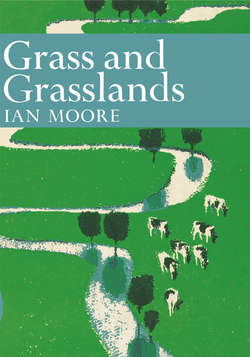Читать книгу Grass and Grassland - Ian Moore - Страница 10
CHAPTER 4 TYPES OF BRITISH GRASSLAND
ОглавлениеCenturies of biotic influence have brought about the formation of our so-called natural types of grassland, for even the wild stretches of hill and moorland, which to most people epitomise natural grassland, owe their existence to the influence of countless generations of grazing animals, particularly sheep. Without man’s influence heather, bracken, and scrubby growth soon colonise the land to act as the forerunners of bush, pine and rowan until a dense forest growth occupies the countryside. Let us, therefore, be precise and speak of uncultivated and cultivated grassland. The former group includes moors, downs, wolds, heaths and fens, broadly termed rough grazings, while the latter includes the rich permanent pastures and meadows which are “cultivated” by regular mechanical treatment with harrows and rollers and receive periodic applications of the essential plant nutrients though the turf is left undisturbed. Included in this group is the ley or short duration grassland which is ploughed periodically. The subdivisions are clearly seen in table 4:
TABLE 4. SUBDIVISIONS OF GRASSLAND
| Uncultivated grassland | Cultivated grassland | |
|---|---|---|
| moors: (north and west of Britain) | permanent | temporary |
| downs: (south and east) | pastures | leys |
| heaths: (south and east) | and | of |
| fens: (mainly in the east) | meadows | varying |
| duration |
The transition from ley to permanent pasture or meadows, thence to rough grazing and scrub, and finally to forest, is an orderly, gradual process, the different phases being clearly recognisable yet merging one with another. The great areas of rough grazings are known to all countrymen and townsmen alike and a brief outline of the different types of grassland in this group will give added interest to the countryside.
The soil of our moorland areas, including those of Scotland and the Lake District, the Pennines, the Yorkshire moors of the north-east, the Welsh mountains, and the moors of Cornwall, Devon and Somerset, is acid or “sour” and a marked lime shortage is invariably associated with a deficiency in phosphate and potash. Under such conditions our useful grasses and clovers cannot survive and the flora is very restricted and specialised, the degree of acidity, the rainfall and the drainage determining the specific type of herbage found in any particular stretch of moor. Free-draining land is often in close proximity to bog, but in the majority of cases the sterile condition of the soil has resulted in an accumulation of undecomposed vegetation, “mat,” near the surface and the grassland is said to be “matted.”
On the wetter soils the dominant species is often flying bent (Molinia), the long straws of which were once used by country people for making stiff carpet brushes. Should the peat be waterlogged then cotton grass, deer grass, heath or square-stemmed rush will be found in varying amounts. If the peat is well drained, as on hill sides and knolls, the soil still being very acid, then the dominant grass is matgrass, so named because it grows in dense matted tufts, the hard bristle-like wiry leaves being much too tough for cattle or sheep to eat. Often associated with matgrass will be sheep’s fescue, bilberry and heather. On really deep soil, which is fundamentally good land, bracken is frequently dominant, and when this land is cultivated it yields excellent crops of potatoes and oats. So runs the old adage, “Copper under Heather, Silver under Gorse, Gold under Bracken,” which proved so true in the wartime ploughing-up campaign of 1939–45. Heather land yielded poor crops, even with generous fertiliser treatment, for the soil was too hungry and lacked body, whereas surprisingly good crops followed the ploughing in of bracken. Gorse land gave results somewhere between the heather and the bracken.
Heather moor is primarily sheep country and normally carries about one ewe to four or five acres. Hardy cattle, such as the Galloway, may sometimes be seen in association with sheep on the best moors. The periodic burning of the heather prevents the development of scrub and encourages new growth and, in late winter especially, young heather shoots are valuable in providing adequate sustenance for the sheep. When the burning is too slow, i.e. the fire does not sweep rapidly over the heather and the roots are damaged in consequence, bilberry frequently replaces the heather which represents the next phase in the succession.
The most valuable of the moorland or hill pastures contain sheep’s fescue, red fescue and bent as the dominant species and although these grasses are at the bottom of the nutritional scale as we shall see, they have the advantage of demanding the minimum of attention from the farmer in order to keep a stable sward. Bracken is generally the most serious intruder but this can be kept in check with regular attention. On the moors of Cornwall and Devon rough uncultivated pastures contain Agrostis setacea
